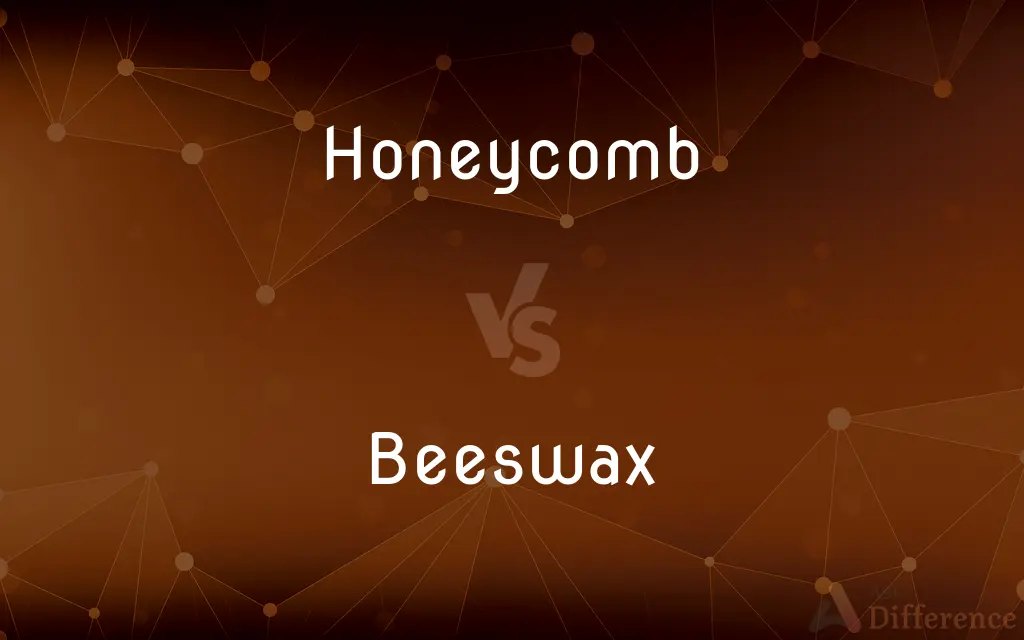Honeycomb vs. Beeswax — What's the Difference?
By Tayyaba Rehman & Urooj Arif — Updated on April 2, 2024
Honeycomb is a natural structure created by bees for storing honey and larvae, while beeswax is the substance bees produce to construct the honeycomb's walls.

Difference Between Honeycomb and Beeswax
Table of Contents
ADVERTISEMENT
Key Differences
Honeycomb refers to the hexagonal prismatic wax cells built by bees to store their honey and nurture their larvae. This structure showcases the efficiency of nature through its geometric precision, optimizing space without sacrificing strength. On the other hand, beeswax is the raw material secreted by bees from their wax-producing glands. Beeswax forms the foundation of the honeycomb, providing a durable and flexible medium for construction.
While honeycomb is directly associated with the storage of honey and the housing of bee larvae, serving as a vital component of the bee ecosystem, beeswax has applications beyond the beehive. Beeswax is harvested not just for its role in natural bee habitats but also for various human uses, including cosmetics, candles, and polishes, thanks to its non-toxic, water-resistant, and malleable properties.
The creation of honeycomb is a collective effort by bees to maintain the hive's functionality and productivity, illustrating the complex social structure of bee colonies. Beeswax, by contrast, is a byproduct of this industrious behavior, showcasing the bees' ability to produce essential materials for their survival and the well-being of their community.
From a harvesting perspective, honeycomb can be extracted and consumed by humans, offering a unique textural and flavor experience, particularly when the comb is filled with honey. Beeswax extraction, however, focuses on the wax itself, which is purified and repurposed for a variety of commercial and artisanal applications, illustrating its versatility beyond the natural world.
The value of honeycomb extends to its nutritional and medicinal benefits, as it is rich in carbohydrates and contains traces of pollen, propolis, and royal jelly. Beeswax, while not consumed for its nutritional content, is prized for its protective, soothing properties in skin care formulations and for its burn qualities in candle making.
ADVERTISEMENT
Comparison Chart
Definition
A structure of hexagonal cells made by bees for storing honey and rearing larvae
The substance secreted by bees to construct honeycomb
Primary Use
Storage of honey and housing bee larvae
Material for constructing honeycomb and various human applications
Composition
Made of beeswax but valued for its contents (honey, pollen)
Pure beeswax, used in its raw form or processed for various products
Production
Created by bees within the hive for colony needs
Secreted by bees’ wax glands, used to build honeycomb and cap cells
Human Applications
Consumed directly, with honeycomb considered a delicacy
Used in candles, cosmetics, polishes, and more due to its versatile properties
Compare with Definitions
Honeycomb
The hexagonal structure made by bees for honey storage.
We enjoyed the honey straight from the honeycomb.
Beeswax
A substance produced by bees for constructing honeycombs.
Beeswax candles burn with a bright, clean flame.
Honeycomb
Bees' natural storage unit.
The honeycomb was filled with golden, delicious honey.
Beeswax
Versatile material in various industries.
Beeswax is a popular ingredient in natural cosmetics.
Honeycomb
A geometric marvel in bee hives.
The structure of the honeycomb maximizes space efficiency.
Beeswax
Secreted by bees for hive construction.
The beeswax was harvested to make organic lip balm.
Honeycomb
Home for bee larvae and honey.
The beekeeper showed us a frame of honeycomb from the hive.
Beeswax
Base for natural crafting materials.
Beeswax wraps are an eco-friendly alternative to plastic.
Honeycomb
Edible bee product.
Honeycomb can be chewed as a natural gum.
Beeswax
Used in preservation and sealing.
Beeswax seals the jars in traditional canning processes.
Honeycomb
A honeycomb is a mass of hexagonal prismatic wax cells built by honey bees in their nests to contain their larvae and stores of honey and pollen. Beekeepers may remove the entire honeycomb to harvest honey.
Beeswax
Beeswax (cera alba) is a natural wax produced by honey bees of the genus Apis. The wax is formed into scales by eight wax-producing glands in the abdominal segments of worker bees, which discard it in or at the hive.
Honeycomb
A structure of hexagonal, thin-walled cells constructed from beeswax by honeybees to hold honey and larvae.
Beeswax
The yellow to grayish-brown wax secreted by the honeybee for constructing honeycombs.
Honeycomb
Something resembling this structure in configuration or pattern.
Beeswax
Commercial wax obtained by processing and purifying the crude wax of the honeybee and used in making candles, crayons, and polishes.
Honeycomb
To fill with holes or compartments; riddle
Cliffs that were honeycombed with caves and grottoes.
Beeswax
(Informal) A matter of concern or business that pertains to someone
It's none of your beeswax where I'm going tonight.
Honeycomb
To form in or cover with a pattern like that of a honeycomb.
Beeswax
A wax secreted by bees from which they make honeycomb; or, the processed form of this wax used in the manufacture of various goods.
Honeycomb
A structure of hexagonal cells made by bees primarily of wax, to hold their larvae and for storing the honey to feed the larvae and to feed themselves during winter.
Beeswax
“Business”, as in such phrases as mind your own beeswax and none of your beeswax.
Honeycomb
(by extension) Any structure resembling a honeycomb.
The wood porch was a honeycomb of termite tunnels before we replaced it.
Beeswax
(transitive) To polish with beeswax.
Honeycomb
(construction) Voids left in concrete resulting from failure of the mortar to effectively fill the spaces among coarse aggregate particles.
Beeswax
The wax secreted by bees, and of which their cells are constructed.
Honeycomb
(aviation) Manufactured material used to manufacture light, stiff structural components using a sandwich design.
Beeswax
A yellow to brown wax secreted by honeybees to build honeycombs
Honeycomb
(solar cell) The texture of the surface of a solar cell, intended to increase its surface area and capture more sunlight.
Beeswax
Cover with beeswax;
Chris beeswaxed the kitchen table
Honeycomb
(geometry) A space-filling packing of polytopes in 3- or higher-dimensional space.
Honeycomb
To riddle something with holes, especially in such a pattern.
Termites will honeycomb a porch made of untreated pine.
Honeycomb
A mass of hexagonal waxen cells, formed by bees, and used by them to hold their honey and their eggs.
Honeycomb
Any substance, as a easting of iron, a piece of worm-eaten wood, or of triple, etc., perforated with cells like a honeycomb.
Honeycomb
A framework of hexagonal cells resembling the honeycomb built by bees
Honeycomb
Carve a honeycomb pattern into;
The cliffs were honeycombed
Honeycomb
Penetrate thoroughly and into every part;
The revolutionaries honeycombed the organization
Honeycomb
Make full of cavities, like a honeycomb
Common Curiosities
Can you eat honeycomb?
Yes, honeycomb is edible and considered a delicacy, often eaten with honey.
What is honeycomb used for?
Honeycomb is used by bees to store honey and rear their larvae; humans consume it for its honey and wax.
What are the main uses of beeswax?
Beeswax is used in candles, cosmetics, food wraps, and as a polish or sealant.
How do bees produce beeswax?
Bees produce beeswax through special glands on their abdomen, secreting it as wax droplets.
Are there health benefits to eating honeycomb?
Honeycomb is rich in carbohydrates and contains traces of pollen, propolis, and royal jelly, offering various health benefits.
Can beeswax be eaten?
While beeswax is not harmful, it is not commonly eaten for nutritional purposes but used in food processing and preservation.
What is beeswax?
Beeswax is a natural substance produced by bees to build the honeycomb structure.
Is honeycomb the same as beeswax?
No, honeycomb is the structure made from beeswax, primarily for storing honey and larvae.
How is beeswax harvested?
Beeswax is harvested by melting and purifying the wax caps and structures from bee hives.
How long does beeswax last?
Beeswax has a long shelf life and can last many years if stored properly.
Is honeycomb vegan?
No, honeycomb is not considered vegan as it is produced by bees and involves bee labor.
How do bees use honeycomb?
Bees use honeycomb to store honey, pollen, and to house their larvae and queen.
What makes beeswax unique?
Beeswax is valued for its non-toxic, water-resistant, and malleable properties, making it versatile for many applications.
Why is honeycomb shaped hexagonally?
The hexagonal shape maximizes space efficiency and structural strength with minimal wax.
What are the environmental benefits of using beeswax?
Beeswax is a sustainable, biodegradable alternative to synthetic materials, reducing pollution and supporting bee populations.
Share Your Discovery

Previous Comparison
Ruffle vs. Shuffle
Next Comparison
Serviette vs. TissueAuthor Spotlight
Written by
Tayyaba RehmanTayyaba Rehman is a distinguished writer, currently serving as a primary contributor to askdifference.com. As a researcher in semantics and etymology, Tayyaba's passion for the complexity of languages and their distinctions has found a perfect home on the platform. Tayyaba delves into the intricacies of language, distinguishing between commonly confused words and phrases, thereby providing clarity for readers worldwide.
Co-written by
Urooj ArifUrooj is a skilled content writer at Ask Difference, known for her exceptional ability to simplify complex topics into engaging and informative content. With a passion for research and a flair for clear, concise writing, she consistently delivers articles that resonate with our diverse audience.
















































